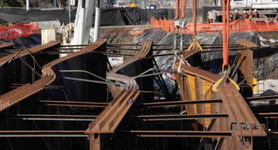Enhineyero
Structural
Floor joist and purlins are installed with blocking/bridging to act as lateral restraint, where then does the force on the blocking/bridging end up?
Follow along with the video below to see how to install our site as a web app on your home screen.
Note: This feature may not be available in some browsers.

Floor joist and purlins are installed with blocking/bridging to act as lateral restraint, where then does the force on the blocking/bridging end up?
What do you mean by this? It talks a lot about twist restraints, with the presence of absence of twist restraint being a key factor in determining whether you have full, partial, lateral or no restraint at a given cross section.I deal with AS4100. It is intently focussed on lateral restraint of the compression flange and doesn't at all address twist restraint of a member
It talks about restraint of the critical flange. For a cantilever this is actually the tension flange.I deal with AS4100. It is intently focussed on lateral restraint of the compression flange
Sorry I could have wording my statement better. Obviously it mentions twist restraint, but it REQUIRES lateral restraint in all cases.What do you mean by this? It talks a lot about twist restraints, with the presence of absence of twist restraint being a key factor in determining whether you have full, partial, lateral or no restraint at a given cross section.


Yeah fair enough. It’s odd how the code ignores pure twist restraint. What sort of beams is AS 4100 so concerned about that can laterally-torsionally buckle without twisting? And at the same time the code treats lateral restraints as capable of inhibiting buckling, end of story, even though in some circumstances beams can buckle through L-restraints, resulting in real buckling lengths longer than what AS4100 assumes.but it REQUIRES lateral restraint in all cases.
What if all adjacent members are working (whole floor is subjected to design load) and require a restraint as well? This restraining force has to go somewhere.Into adjacent members and into connected diaphragms e.g. roof sheeting.
What if all adjacent members are working (whole floor is subjected to design load) and require a restraint as well? This restraining force has to go somewhere.
The beams I'm talking about are ones with no lateral load path to prevent LTB but with torsional restraint. This is often found in pairs of beams where for whatever reason a lateral load path can't be readily utilised or just isn't necessary.Yeah fair enough. It’s odd how the code ignores pure twist restraint. What sort of beams is AS 4100 so concerned about that can laterally-torsionally buckle without twisting?
The beams I'm talking about are ones with no lateral load path to prevent LTB but with torsional restraint. This is often found in pairs of beams where for whatever reason a lateral load path can't be readily utilised or just isn't necessary.
